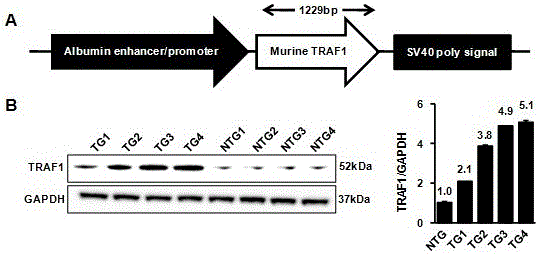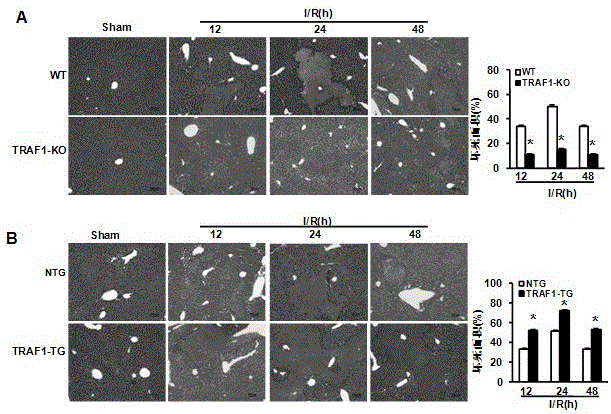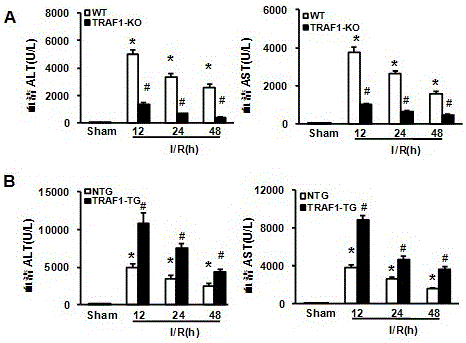Application of TNF receptor-related factor 1 (tarf1) and its inhibitors in liver ischemic diseases
A related factor, liver ischemia technology, applied in cardiovascular system diseases, antibodies, gene therapy, etc.
- Summary
- Abstract
- Description
- Claims
- Application Information
AI Technical Summary
Problems solved by technology
Method used
Image
Examples
Embodiment 1
[0036] [Example 1] Construction of hepatocyte-specific TRAF1 transgenic mice
[0037]To further study the effect of TRAF1 overexpression on liver ischemia / reperfusion injury, we constructed several hepatocyte-specific TRAF1 transgenic mice (TRAF1-TG). Transgenic vector construction information: use TRAF1 gene upstream primer, namely 5'-GAACTCGAGCCACCATGGCCTCCAGCTCAGCCCC-3' (SEQ ID NO.1); TRAF1 gene downstream primer, namely 5'-GAATGCGGCCGCCTAAGCACTAGTGTCCACAA-3' (SEQ ID NO.2), amplify small Mouse TRAF1 full-length gene (NCBI, Gene ID: 22029, XM_006497845.1), insert the cDNA into the pGEM-T vector (Promega company product, product number A1360) downstream of the Albumin promoter, and construct the constructed vector into a fertilized embryo by microinjection (C57BL / 6 background), and hepatocyte-specific TRAF1 transgenic mice were obtained. Genomic DNA was obtained from transgenic mice by cutting their tails, and identified by PCR to detect the structure of the exogenous gene. ...
Embodiment 2
[0040] [Example 2] Mouse liver ischemia-reperfusion injury model (ischemia / reperfusion injury, I / R) was obtained
[0041] 1. Grouping of experimental animals: male C57BL / 6 strain wild-type mice, TRAF1 knockout mice, TRAF1 transgenic mice and non-transgenic mice, liver ischemia model was established by liver ischemia-reperfusion (I / R). They were randomly divided into 8 groups: C57BL / 6J strain wild-type mice sham operation group (WT SHAM) and I / R operation group (WT I / R), TRAF1 knockout mouse sham operation group (KO SHAM) and I / R operation group (KO I / R), non-transgenic mouse sham operation group (NTG SHAM) and I / R operation group (NTG I / R), liver cell-specific TRAF1 transgenic mouse sham operation group (TG SHAM) and I / R surgery group (TG I / R).
[0042] 2. I / R operation of the liver ischemia-reperfusion injury model (using non-invasive vascular clips to clamp the portal vein and hepatic artery in the middle lobe and left lobe, so that about 70% of the liver ischemia) model o...
Embodiment 3
[0048] [Example 3] Determination of liver necrosis area and liver function index
[0049] The evaluation indicators of the severity of liver ischemia / reperfusion injury mainly include the area of liver necrosis and liver function indicators (AST, ALT), all of which are positively correlated with the severity of liver ischemia / reperfusion injury.
[0050] 1. Take materials
[0051] Mice were killed by cervical dislocation in the sham operation group (Sham) and at 12h, 24h, and 48h after ischemia-reperfusion, and 1 mL of blood was collected from the inferior vena cava immediately to separate the serum. At the same time, the left lobe of the liver in the ischemic area with a size of about 1.5cm×1cm×0.2cm was fixed in 10% neutral formalin for 24 hours, dehydrated, embedded, paraffin-sectioned, and HE stained. (Separation of serum: the EP tube that collected the blood was left at room temperature for 1-2 hours to allow the blood to coagulate naturally. Centrifuge at 4°C for 30 m...
PUM
 Login to View More
Login to View More Abstract
Description
Claims
Application Information
 Login to View More
Login to View More - R&D
- Intellectual Property
- Life Sciences
- Materials
- Tech Scout
- Unparalleled Data Quality
- Higher Quality Content
- 60% Fewer Hallucinations
Browse by: Latest US Patents, China's latest patents, Technical Efficacy Thesaurus, Application Domain, Technology Topic, Popular Technical Reports.
© 2025 PatSnap. All rights reserved.Legal|Privacy policy|Modern Slavery Act Transparency Statement|Sitemap|About US| Contact US: help@patsnap.com



